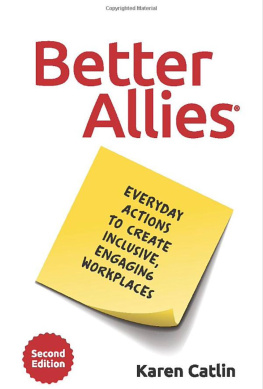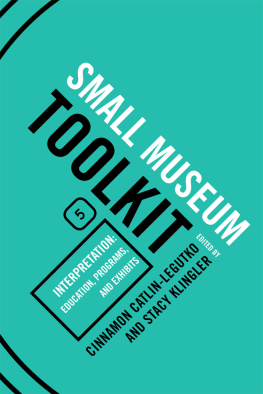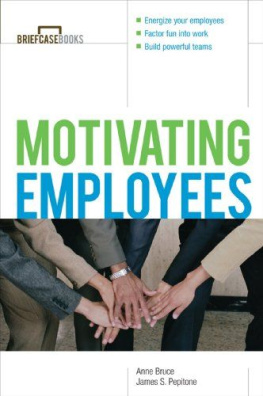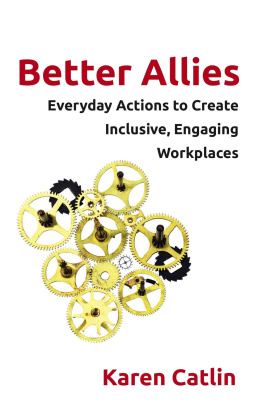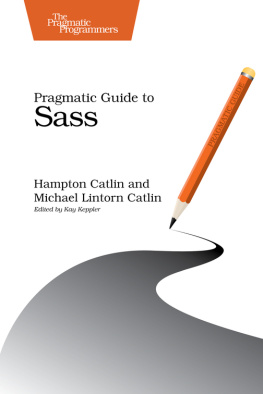Are you looking for tangible ways to counteract prejudice at work? Entrepreneur Karen Catlin sheds light on how to become a workplace ally to underrepresented and marginalized employees. Her guide to inclusivity will help you identify and call out acts of microaggression, exclusion, racism and hostility. Catlins advice is primarily geared toward white men, but anyone in a position of power can learn from her clear-eyed, wide-ranging counsel.
Summary
Diverse workplaces are happier and more innovative.
Workplace diversity isnt just an ethical imperative its good for business. Diverse companies are more creative and cutting-edge and their employees more content. Inclusive businesses, however, are not always easy to cultivate. Women, people of color, LGBTQ people, those with disabilities and other groups still face oppression. The hurdles they face range from harassment and reduced promotional opportunities to hiring discrimination. From Microsoft CEO Satya Nadellas suggestion that women shouldnt request raises to Googles anti-diversity manifesto, examples of ignorance and gaffes abound.
Foster thriving, diverse workspaces through effective allyship.
People in positions of organizational power can do a lot to cultivate workplace diversity by being allies to underrepresented employees. Allies work to include everyone in meetings and workplace events. They build a diverse professional network and workforce. They shut down showboaters and idea hijackers and amplify underrepresented voices. For example, women can adopt a strategy of amplification during staff meetings. When one female staffer makes a valuable contribution, other women can repeat it and credit the author. This forces others in the meeting to recognize the input and rebuffs their ability to claim the idea as their own.
Genuine allies can make legitimate improvements over time and with consistent effort. You must be an open-minded, continuous learner, who can digest constructive criticism. It requires patience, not perfection, and an ongoing effort to learn from your mistakes. Small, good deeds make a difference. The simple act of speaking up in a meeting can have a ripple effect.
Allies must understand and harness their own privilege to assist people with fewer advantages.
Every discussion of allyship begins with a conversation about privilege. Privilege comprises any benefit conferred to a social group based on characteristics other than merit. Privilege can be attached to race, class, gender, ability, sexual orientation, age, education, language, location and religious affiliation, to name a few.
Its up to people who hold positions of privilege to be active allies to those with less access, and take responsibility for making changes that will help others be successful.
These categories often overlap in complex or intersectional ways. People may marginalize others in multiple categories. The less privileged are more likely to experience prejudice and violence.
The term privileged is not an intentional insult designed to belittle peoples experiences, or to suggest they have not worked hard. Its a method of discussing how society perceives and treats people with certain characteristics and how those perceptions might impact outcomes, personal confidence levels, and the ability to help others. The term should not be used to single out white men; it can offer an analytic framework applicable to nearly everyone.
With great privilege comes great responsibility. To promote equality and diversity, people who hold privilege can and should be allies to those who are disadvantaged.
From advocacy to scholarship, allyship takes many forms.
Successful allies promote underrepresented groups in numerous ways. Frameworks for allyship include:
- The sponsor This ally promotes the talents and knowledge of those in underrepresented groups and recommends them for roles that provide learning opportunities and exposure to a wider network.
- The champion This ally directs employees from underrepresented groups to the right people with relevant expertise. Champions step aside to let other qualified people vocally advocate for more representation.
- The amplifier This ally repeats and endorses great ideas and creates a code of conduct to promote equitable communication. Amplifiers invite underrepresented individuals to engage in activities that make them more visible, for example, speaking at meetings or writing newsletters.
- The advocate This ally ensures underrepresented employees are invited to events, introduced within a network and given ample opportunities to collaborate.
- The scholar These allies educate themselves through information gathering, like listening to podcasts, and reading articles or other media. Scholars solicit feedback from underrepresented groups and listen attentively. They research their challenges without burdening them to explain themselves.
- The upstander This ally speaks up about injustices, redirects provocative, inappropriate questions and interrupts ongoing harassment.
- The confidant This ally believes in people, invites them into conversations and maintains an open-door policy.
Dont play savior.
An ally is never a savior or knight in shining armor in any of these scenarios. Consider the example of a prospective hire, where the hiring committee uses subjective, inconsistent criteria to evaluate a candidate from an underrepresented community. The committee cannot fully articulate why it regards the candidate as a poor fit. A knight would leap to this candidates defense and insist the company hire him or her. An ally would instead examine the systemic issue the criteria the company uses to evaluate candidates and ask the committee to develop standardized, objective benchmarks connected to the jobs required skill set.
I dont want to view anyone who is underrepresented as a virtual damsel in distress.
To avoid the knight trap, ask: How many people will my initiative help? What is its goal? How will it change the company in the short and long term? Will it enhance equality or equity? Your goal is to create equity by allocating resources fairly, as opposed to indiscriminately applying the same solution across the board. Do what is right, not what is simplest or most convenient.
Doing whats right instead of whats easy will lead to a more inclusive workplace where everyone can thrive and that will result in more innovation, better solutions for customers and better business results.

